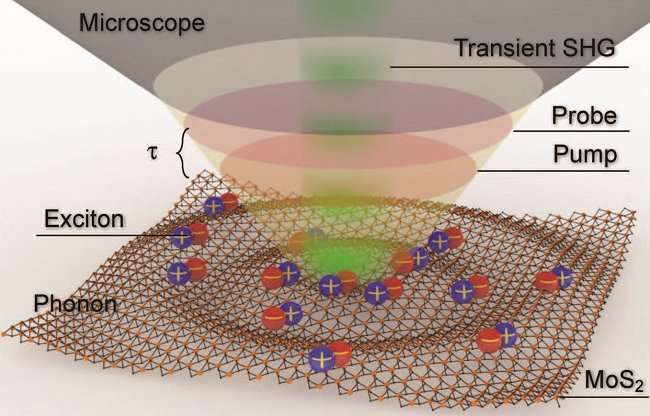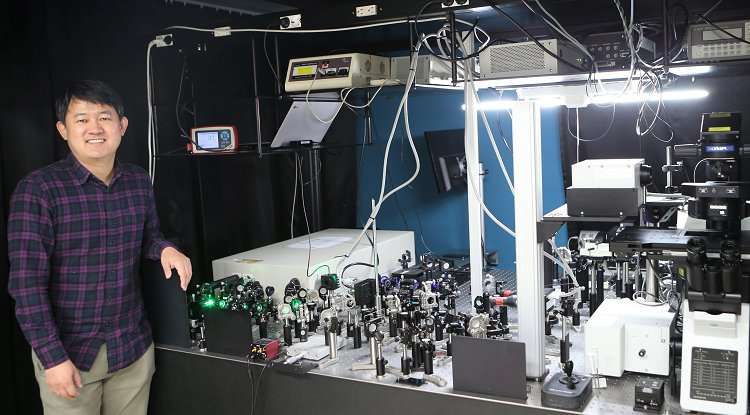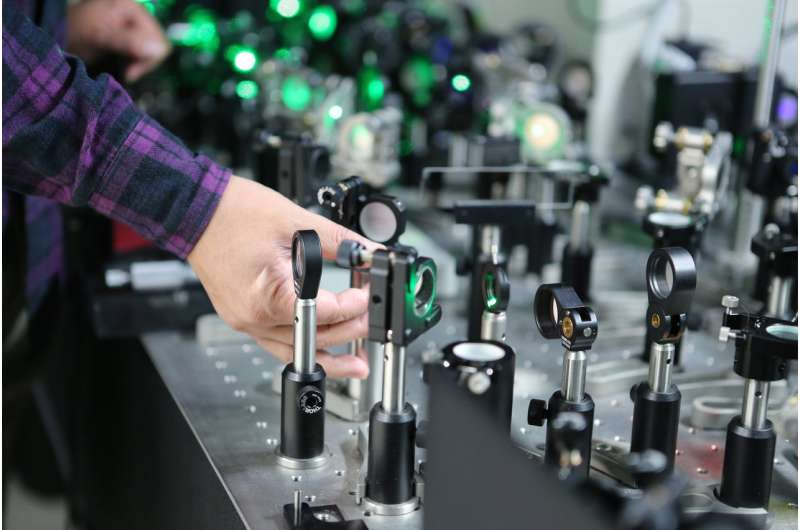Imaging sound movements of atomic units with an optical microscope

An international team of researchers, led by Dr. Hyunmin Kim of Companion Diagnostics and Medical Technology Research Group at DGIST developed an imaging technique to monitor the sound movement of an atomically thin substance at high resolution. The technology could be used in the development of new materials, solar cells and catalysts.
The research team has presented a transient second-harmonic generation (TSHG) pulse imaging system that can analyze the ultra-fast dynamics of light interacting with molybdenum disulfide (MoS2), a typical 2-D atom laminating structure, at a resolution of 300 nanometers.
Existing equipment used for measuring ultrasonic waves generated by the vibration of ultrafast electrons and lattice had limited applications due to the noise ratio compared to low signal and spatial resolution. The research team developed a microscope with improved optical resolution for quick and accurate analysis of material characteristics in the mass production era of semiconductor 2-D materials.
TSHG imaging technology developed by the researchers can measure sound generation at the level of 1011 Hz unit (1 Hz vibrates once per one second), which is generated by the reaction of a lattice and electron moved by a pump pulse having a different wavelength, using the generation of a wavelength that is half of the pro pulse wavelength at the point where symmetry is broken on a crystal substance.

Previously, to measure the ultrafast electron movement on the scale of a femtosecond (10-15 second) in a 2-D atomic unit structure or the generation of related sound, a pulse wave in the pump-probe had to be exposed to a material. The change in the absorption or reflection of the generated probe pulse was measured for analysis. However, the signals were small, so the measurement time had to be extended and a high-performance signal amplifier had to be used to increase the signal-to-noise ratio. The laser had high energy, and could thus cause sample damage and lead to a detachable state of the molecules if the focus size of the laser was adjusted to below a micrometer. There were also limitations in analysis if the sample size was small.
In this study, to decrease the laser focus size while reducing damage to the sample, Dr. Kim and his team decreased the laser output used in an existing transient-absorption spectroscope by thousands to tens of thousands of times, and applied a high-performance scanning system to visualize it in real-time.
The research team increased the substance penetration level of the laser using a near-infrared ray pulse length of 1.04 size as a probe pulse and located the secondary harmonic pulse length on the visible ray section of green color (520 nm). Using this method, they maximized efficiency to analyze the movement of electrons to the ionization energy section of the dense energy band of the 2-D substance when combined with the pump pulse.

According to the research team, it is proved that the new imaging technology is useful to analyze various atomic structures such as hexagon and triangular stars, by combining the Second-Harmonic Generation of Pulse Imaging System with a 4-wave mixed pulse imaging function and applying it to lamination structural analysis of molybdenum disulfide manufactured using the chemical vapor deposition (CVD) method.
In addition, the TSHG technique is expected to contribute to research on related materials. The research can be applied to studies of electron lifespan that determine the efficiency of energy materials and catalysts such as 2-D materials and perovskite and quantum dots.
Dr. Kim said, "The electron-hole movement analysis of materials which are mass-produced using the transient second-harmonic generation of pulse imaging technology can be visualized simultaneously, which will contribute greatly to the development of source technology based on new nano-materials. We will research and develop super-precision energy and optical elements by expanding the high-resolution real-time analysis technology we have secured to the analysis of physical lattice constraint environments."
More information: Houk Jang et al, Transient SHG Imaging on Ultrafast Carrier Dynamics of MoS2 Nanosheets, Advanced Materials (2018). DOI: 10.1002/adma.201705190
Journal information: Advanced Materials
Provided by DGIST





















